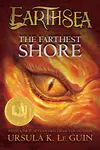
Adam Shields

Summary: A mature Ged tries to save magic.
In the Farthest Shore, Ged, now mature and the Archmage (the head wizard of Roke) is on a quest with Prince Arren to discover why magic seems to be disappearing from Earthsea. Prince Arren is a teen and is in awe of Ged and quickly agrees to come along when Ged asks him to. In part this is the story of Arren coming of age and maturing.
I want to like The Farthest Shore much more than I do. But it seems unquestionably true that this is the weakest book of the series. I think there is a couple reasons for that. I think the first is that is feels a bit derivative. The Farthest Shore was published in 1972 and the buddy quest, especially the last part feels like Frodo and Sam's quest to get rid of the ring.
The other part is that Ged is a bit too powerful in the book. While Arren doesn't really understand why Ged doesn't use his power more often at the start of the book, that isn't because Ged is weak and can't do magic. This is similar to the Superman problem. If nothing can defeat Superman, then the conflict within the book falls flat. I think the strength of the first book was the psychological tension of Ged at war with himself. And when he is such a powerful wizard that there is no one else that can really take him on except himself, it makes it hard to have a real villain to the story.
That leads to a third problem, the villain here feels like a cardboard cutout. The villain in the first book was really Ged himself. The villain in the second book wasn't really the others in the temple that were trying to prevent Ged from recovering the magic artifact, but tradition that kept Tenar and the others trapped. But in this third book there is a villain and the villain isn't really up to the task. The conflict of the book is mostly the quest not the villain, but even though the book is mostly centered on Arren discovering himself in the quest, I think that either Le Guin needed to more fully embrace that, or needed a better villain.
This book is needed to set up what became the fourth book of the series. The Farthest Shore was published in 1972 and the fourth book, Tehanu, was not published until 1990. Tehanu has a smaller scope, but it is a better book.
This originally posted on my blog at https://bookwi.se/the-farthest-shore/
Originally posted at bookwi.se.
Summary: A mature Ged tries to save magic.
In the Farthest Shore, Ged, now mature and the Archmage (the head wizard of Roke) is on a quest with Prince Arren to discover why magic seems to be disappearing from Earthsea. Prince Arren is a teen and is in awe of Ged and quickly agrees to come along when Ged asks him to. In part this is the story of Arren coming of age and maturing.
I want to like The Farthest Shore much more than I do. But it seems unquestionably true that this is the weakest book of the series. I think there is a couple reasons for that. I think the first is that is feels a bit derivative. The Farthest Shore was published in 1972 and the buddy quest, especially the last part feels like Frodo and Sam's quest to get rid of the ring.
The other part is that Ged is a bit too powerful in the book. While Arren doesn't really understand why Ged doesn't use his power more often at the start of the book, that isn't because Ged is weak and can't do magic. This is similar to the Superman problem. If nothing can defeat Superman, then the conflict within the book falls flat. I think the strength of the first book was the psychological tension of Ged at war with himself. And when he is such a powerful wizard that there is no one else that can really take him on except himself, it makes it hard to have a real villain to the story.
That leads to a third problem, the villain here feels like a cardboard cutout. The villain in the first book was really Ged himself. The villain in the second book wasn't really the others in the temple that were trying to prevent Ged from recovering the magic artifact, but tradition that kept Tenar and the others trapped. But in this third book there is a villain and the villain isn't really up to the task. The conflict of the book is mostly the quest not the villain, but even though the book is mostly centered on Arren discovering himself in the quest, I think that either Le Guin needed to more fully embrace that, or needed a better villain.
This book is needed to set up what became the fourth book of the series. The Farthest Shore was published in 1972 and the fourth book, Tehanu, was not published until 1990. Tehanu has a smaller scope, but it is a better book.
This originally posted on my blog at https://bookwi.se/the-farthest-shore/
Originally posted at bookwi.se.